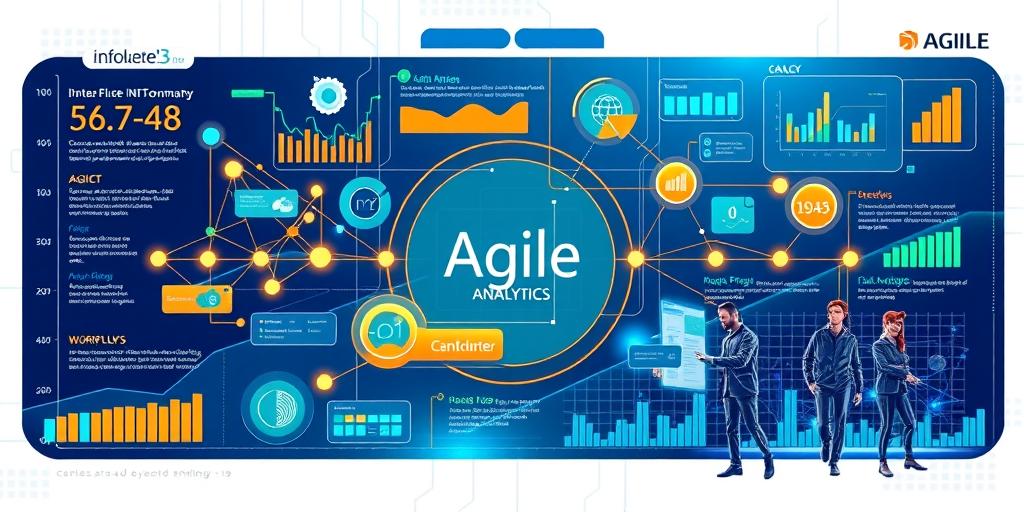Do you want to dramatically improve your Agile development process? The secret weapon you’ve been missing might be hidden in plain sight: data analytics. In today’s fast-paced software development world, understanding how to leverage the power of data is no longer a luxury—it’s a necessity for staying competitive. This comprehensive guide will show you exactly how integrating data analytics into your Agile workflow can lead to faster development cycles, higher quality products, and ultimately, greater success. Prepare to be amazed by the transformative power of data-driven Agile!
Understanding the Synergy Between Data Analytics and Agile
Agile methodologies, with their iterative approach and emphasis on flexibility, have revolutionized software development. But even the most experienced Agile teams can benefit from a data-driven approach. By tracking key metrics and analyzing the data, teams can identify bottlenecks, optimize processes, and make informed decisions throughout the development lifecycle. This data-driven approach isn’t about micromanaging; it’s about empowering teams with the insights they need to continuously improve.
Key Metrics to Track
Several key metrics can provide invaluable insights. Consider tracking sprint velocity, bug counts, code churn, and cycle time. Analyzing these metrics can reveal trends, highlight areas for improvement, and predict future performance. For example, consistent declines in sprint velocity might indicate resource constraints or overly ambitious sprint goals. High bug counts in a specific area could highlight a need for improved testing or code reviews. Understanding these correlations is vital.
Data Visualization for Enhanced Insights
Don’t let your data become a wall of numbers. Use data visualization techniques like dashboards and charts to transform raw data into easily digestible insights. A well-designed dashboard can provide a clear overview of team performance and identify areas needing attention. This visual representation makes it easier for team members at all levels to understand and contribute to improvement efforts. The right visualization can be the difference between data being ignored and data being used to drive real change.
Implementing Data Analytics in Your Agile Workflow
Integrating data analytics into an existing Agile workflow requires a strategic approach. Begin by identifying the most important metrics for your team. Then, establish a system for collecting and analyzing the data, perhaps using tools like Jira, Azure DevOps, or dedicated analytics platforms. Remember to automate data collection where possible to minimize manual effort and ensure data accuracy. The easier it is to collect data, the more likely it will be collected consistently and used correctly.
Choosing the Right Tools
The tools you use will significantly impact your success. Consider factors like ease of integration with your existing Agile tools, the types of data visualization options offered, and the level of customization available. There’s a wide range of tools available, from simple spreadsheets to sophisticated analytics platforms. Selecting the appropriate tool depends heavily on the size and complexity of your project and the overall technical capabilities of your team.
Building a Data-Driven Culture
Successfully integrating data analytics into your Agile workflow requires more than just implementing the right tools; it requires building a data-driven culture. Foster a culture of transparency and experimentation within your team. Encourage team members to actively use the data to inform their decisions and to share their insights with others. A successful data-driven approach requires buy-in from every team member. Regular training sessions and presentations about data interpretation and its use can help immensely.
Leveraging Data Analytics for Continuous Improvement
Data analytics isn’t a one-time activity; it’s a continuous process. Regularly review your data, identify trends, and adapt your processes accordingly. This iterative approach is key to continuously improving your Agile workflow and maximizing the benefits of data analytics. Using data to inform your sprints and to react to unexpected outcomes is vital to the success of data-driven agile development.
Predictive Analytics for Agile Success
Advance your data-driven approach by incorporating predictive analytics. By analyzing historical data, you can predict future performance and proactively address potential issues. For example, by analyzing historical sprint data, you can predict how long future sprints will take, allowing for more accurate planning and resource allocation. Predictive analytics can transform your agile methodology from reactive to proactive, avoiding many potential problems altogether.
Real-World Examples
Numerous organizations have successfully implemented data analytics in their Agile workflows. These organizations have demonstrated improvements in productivity, quality, and overall project success. Studying these real-world examples can provide valuable insights and inspiration for your own team. Examining these case studies can provide specific, actionable tips for integrating data into your existing system.
Embrace the power of data. By integrating data analytics into your Agile development process, you can unlock new levels of efficiency, quality, and success. Don’t just react to problems; anticipate them. Don’t just improve incrementally; transform your workflow completely. The future of Agile is data-driven, and the time to start is now!
Ready to revolutionize your Agile workflow with data? Contact us today for a free consultation!




